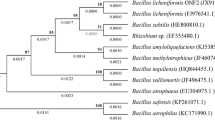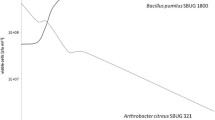Abstract
The present study reports a simple rapid method for isolating the zinc-containing metalloprotease camelysin from Bacillus thuringiensis subsp. israelensis (Bti) by extraction from intact bacterial cells with egg l-α-phosphatidylcholine containing monolamellar liposomes, followed by separation on a sucrose gradient. Characterization of the isolated camelysin revealed a molecular weight of 23 kDa and a pI of 6.2. The camelysin exhibited maximal activity against the substrate azocasein at a temperature of 37°C and pH 7.5. However, the enzyme’s activity remained high also at basic pH values (8–10). In a rich growth medium (LB), camelysin appeared at the late logarithmic phase of Bti growth and reached its maximum in the stationary phase. Camelysin was shown to activate the protoxins Cyt1Aa and Cyt2Ba produced by Bti. The hemolytic activity of Cyt1Aa increased from 40 to 70% and that of Cyt2Ba from 6 to 50% in the presence of 50% (w/w) camelysin. It is concluded that these protoxins can be activated not only by insect gut proteases, but also by the endogeneous metalloprotease camelysin of the Bti bacterium.




Similar content being viewed by others
References
Al-yahyaee SAS, Ellar DJ (1995) Maximal toxicity of cloned CytA d-endotoxin from Bacillus thuringiensis subsp. israelensis requires proteolytic processing from both the N- and C-termini. Microbiology 141:3141–3148
Bai C, Vick AB, Yi S-X (2002) Characterization of a new Bacillus thuringiensis isolate highly active against Cochylis hospes. Curr Microbiol 44:280–285
Baum JA, Malvar T (1995) Regulation of insecticidal crystal protein production in Bacillus thuringiensis. Mol Microbiol 18:1–12
Berry C, O’Neil S, Ben-Dov E, Jones AF, Murphy L, Quail MA, Holden MT, Harris D, Zaritsky A, Parkhill J (2002) Complete sequence and organization of pBtoxis, the toxin-coding plasmid of Bacillus thuringiensis subsp. israelensis. Appl Environ Microbiol 68:5082–5095
Brownbridge M, Margalit J (1986) New Bacillus thuringiensis strains isolated in Israel are highly toxic to mosquito larvae. J Invertebr Pathol 48:216–222
Butko P (2003) Cytolytic toxin Cyt1A and its mechanism of membrane damage: data and hypotheses. Appl Environ Microbiol 69:2415–2422
Cahan R, Axelrad I, Safrin M, Ohman DE, Kessler E (2001) A secreted aminopeptidase of Pseudomonas aeruginosa. Identification, primary structure, and relationship to other aminopeptidases. J Biol Chem 276:43645–43652
Charles J-F, Nielsen-LeRoux C (2000) Mosquitocidal bacterial toxins: diversity, mode of action and resistance phenomena. Memorias do Institito Oswaldo Cruz 95(Suppl I):201–206
Dai SM, Gill SS (1993) In vitro and in vivo proteolysis of the Bacillus thuringiensis subsp. israelensis CryIVD protein by Culex quinquefasciatus larval midgut proteases. Insect Biochem Mol Biol 23:273–283
Donovan WP, Tan Y, Slaney AC (1997) Cloning of the nprA gene for neutral protease A of Bacillus thuringiensis and effect of in vivo deletion of nprA on insecticidal crystal protein. Appl Environ Microbiol 63:2311–2317
Fricke B, Buchmann T, Friebe S (1995) Unusual chromatographic behaviour and one-step purification of a novel membrane proteinase from Bacillus cereus. J Chromatogr A 715:247–258
Fricke B, Drössler K, Willhardt I, Schierhorn A, Menge S, Rücknagel P (2001) The cell envelope-bound metalloprotease (camelysin) from Bacillus cereus is a possible pathogenic factor. Biochim Biophys Acta 1537:132–146
Gill SS, Cowles GJ, Pietrantonio PV (1992) The mode of action of Bacillus thuringiensis endotoxins. Annu Rev Entomol 37:615–636
Grass G, Schierhorn A, Sorkau E, Müller H, Rücknagel P, Nies DH, Fricke B (2004) Camelysin is a novel surface metalloproteinase from Bacillus cereus. Infect Immun 72:219–228
Goldberg LH, Margalit J (1977) A bacterial spore demonstrating rapid larvicidal activity against Anopheles sergentii, Uranotaenia unguiculata, Culex univitatus, Aedes aegypti and Culex pipiens. Mosq News 37:355–358
Guerchicoff A, Ugalde RA, Rubinstein CP (1997) Identification and characterization of a previously undescribed cyt gene in Bacillus thuringiensis subsp. israelensis. Appl Environ Microbiol 63:2716–2721
Hofte H, Whiteley H (1989) Insecticidal crystal proteins of Bacillus thuringiensis. Microbiol Rev 53:242–255
Koni PA, Ellar DJ (1994) Biochemical characterization of Bacillus thuringiensis cytolytic delta-endotoxins. Microbiology 140:1869–1880
Li J, Koni PA, Ellar DJ (1996) Structure of the mosquitocidal delta-endotoxin CytB from Bacillus thuringiensis sp. kyushuensis and implications for membrane pore formation. J Mol Biol 257:129–152
Margalith Y, Ben-Dov E (2000) Biological control by Bacillus thuringiensis subsp. israelensis. In: Rechcigl JE, Rechcigl NA (eds) Insect pest management: techniques for environmental protection. CRC Press, Boca Raton, FL, pp 243–301
Mizuki E, Ohba M, Akao T, Yamashita S, Saitoh H, Park YS (1999) Unique activity associated with non-insecticidal Bacillus thuringiensis parasporal inclusions: in vitro cell-killing action on human cancer cells. J Appl Microbiol 86:477–486
Nisnevitch M, Cohen S, Ben-Dov E, Zaritsky A, Sofer Y, Cahan R (2006) Cyt2Ba of Bacillus thuringiensis israelensis: activation by putative endogenous protease. Biochem Biophys Res Commun 344:99–105
Oppert B (1999) Protease interactions with Bacillus thuringiensis insecticidal toxins. Insect Biochem Physiol 45:1–12
Promdonkoy B, Ellar DJ (2000) Membrane pore architecture of a cytolytic toxin from Bacillus thuringiensis. Biochem J 350:275–282
Reddy S, Kumar NS, Venkateswertlu G (1998) Comparative analysis of intracellular proteases in sporulated Bacillus thuringiensis strains. Biotechnol Lett 20:279–281
Saborowski R, Sahling G, Navarette del Toro MA, Walter I, Garc′ıa-Carreño FL (2004) Stability and effects of organic solvents on endopeptidases from the gastric fluid of the marine crab Cancer pagurus. J Mol Catalysis B: Enzymatic 30:109–118
Taler D, Fogel Y, Nitzan Y, Cahan R (2007) Nucleotide sequence A9UF62 EMBL/GenBank/DDBJ databases
Thomas WE, Ellar DJ (1983) Bacillus thuringiensis var. israelensisisraelensis crystal delta-endotoxin: effects on insect and mammalian cells in vitro and in vivo. J Cell Sci 60:181–197
Acknowledgments
This research was supported in part by the Samaria and Jordan Rift Valley Regional R&D Center, the Research Authority of the Ariel University Center of Samaria, and the Rappaport Foundation for Medical Microbiology, Bar-Ilan University (to Y.N.).
Author information
Authors and Affiliations
Corresponding author
Rights and permissions
About this article
Cite this article
Nisnevitch, M., Sigawi, S., Cahan, R. et al. Isolation, Characterization and Biological Role of Camelysin from Bacillus thuringiensis Subsp. israelensis . Curr Microbiol 61, 176–183 (2010). https://doi.org/10.1007/s00284-010-9593-6
Received:
Accepted:
Published:
Issue Date:
DOI: https://doi.org/10.1007/s00284-010-9593-6




